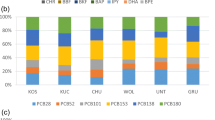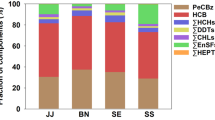Abstract
The aim of this study was to assess the temporal change of atmospheric deposition patterns of persistent organic pollutants (POPs) and polycyclic aromatic hydrocarbons (PAHs) in Switzerland between 1995 and 2014 by a passive biomonitoring with lichens. Lichen tissues sampled at 16 representative sites in the same season of 1995 and 2014 were analyzed for a total of 94 individual and 27 sum parameters of POPs and PAHs by means of gas chromatography-mass spectrometry (GC/MS). The comparative analyses showed a decrease of 40 to 80% (medians) for most of the POPs and PAHs concentration in lichens at all site categories. Reduction in tissue concentration of the polychlorinated dibenzo-p-dioxins/furans (PCDD/PCDFs), such as the highly toxic 2,3,7,8-TetraCDD and the TEQ according to WHO (2005) were 66% and 73%, respectively. For the dioxin- and non-dioxin-like PCBs, a decrease of 67% and 58% was found. The average decrease of 30 organochlorine pesticides and insecticides (OCPs) was 65%, with a 94% decrease for lindane. For the 27 PAHs and for benzo(a)pyrene, an average decrease of 58% and 59% was found. Polybrominated diphenyl ethers (PBDE) showed reduced concentrations in lichens at rural and agglomeration sites, but an increase of contamination was observed at industrial and road traffic sites. The direct comparison of changes of POPs and PAHs concentrations in lichens and of emissions between 1995 and 2014 revealed consistent results. The results of this study highlight for the first time in biota the positive effect of emission regulation of POPs in Switzerland.




Similar content being viewed by others
References
Augusto S, Joao Pereira M, Soares A, Branquinho C (2007) The contribution of environmental biomonitoring with lichens to assess human exposure to dioxins. Int J Hyg Environ-Health 210:433–438. https://doi.org/10.1016/j.ijheh.2007.01.017
Augusto S, Maguas C, Matos J, Maria Joao M, Pereira M, Branquinho C (2010) Lichen PAH concentrations can identify geographic areas that may be out of compliance with regulatory standards. Environ Pollut 158:483–489
Augusto S, Máguas C, Branquinho C (2013a) Guidelines for biomonitoring persistent organic pollutants (POPs), using lichens and aquatic mosses: a review. Environ Pollut 180:330–338
Augusto S, Pereira M, Máguas C, Branquinho C (2013b) A step towards the use of biomonitors as estimators of atmospheric PAHs for regulatory purposes. Chemosphere 92:626–632
Augusto S, Pinho P, Santos A, João Botelho M, Palma-Oliveira J, Branquinho C (2015) Declining trends of PCDD/Fs in lichens over a decade in a Mediterranean area with multiple pollution sources. Sci Total Environ 508(2015):95–100
Blasco M, Domen C, Nerin C (2006) Use of lichens as pollution biomonitors in remote Areas: comparison of PAHs extracted from lichens and atmospheric particles sampled in and around the Somport tunnel (Pyrenees). Environ Sci Technol 2006(40):6384–6391
Cislaghi C, Nimis P (1997) Lichens, air pollution and lung-cancer. Scientific correspondence Nature 387:463–464
Domeno C, Blasco M, Sanchez C, Nerın C (2006) A fast extraction technique for extracting polycyclic aromatic hydrocarbons (PAHs) from lichens samples used as biomonitors of air pollution: dynamic sonication versus other methods. Anal Chim Acta:227371–227381
Fischer A, Hügli C (2015) Polyzyklische aromatische Kohlenwassserstoffe im PM10 an ausgewählten Stationen des NABEL sowie der Kantone Messbericht 2014. EMPA Dübendorf
Herzig R (1990) Entwicklung des Integrierten biologischen Messsystems der Luftverschmutzung mit Flechten in der Schweiz, seine Anwendung und erste Vergleiche mit Bodenanalysen. VDI-Kolloquium: Wirkungen von Luftverunreinigungen auf Böden, 15 - 17. Mai 1990, Lindau. VDI-Berichte 837:937–956
Herzig R (1993a) Multi-residue analysis with passive biomonitoring: a new approach for volatile multi-element contents, heavy metals and polycyclic aromatic hydrocarbons with lichens in Switzerland and the Principality of Liechtenstein. In: Markert B (ed) Plants as biomonitors for heavy metal pollution in the terrestrial environment. VCH Verlagsgesellschaft, Weinheim, pp 285–328
Herzig R (1993b) PAH-Analysen in Flechtenproben und Vergleich mit entsprechenden Immissionsmessungen an vier Standorten der Schweiz. Als Grundlage für den OECD-Workshop on Hazardous Air Pollutants 1993. Im Auftrag des BUWAL, 57 S, London
Herzig R (2002) Persistente organische Luftschadstoffe (POPs) in der Schweiz – Biomonitoring mit Flechten 2002. Umweltmaterialien Nr. 146. Bundesamt für Umwelt, Wald und Landschaft, BUWAL, Bern.
Herzig R (2007a) Monitoring flankierende Massnahmen - Umwelt (MfM-U): Biologisches Luftqualitäts-monitoring mit Flechten entlang der A2 und A13 und Zuweisung relevanter Luftschadstoffe zum Schwerverkehr. Schlussbericht BAFU, Januar 2007, 225 pp. https://www.bafu.admin.ch/bafu/de/home/suche.html#documentsPages. Accessed 22 July 2008
Herzig R (2007b) MfM-U: Monitoring flankierende Massnahmen - Umwelt Teilprojekt – Luftqualitätsmoni-toring mit Flechten entlang der A2 und A13 – Kurzfassung. https://www.bafu.admin.ch/bafu/de/home/suche.html#documentsPages
Herzig R (2017) Persistente organische Schadstoffe (POPs) in Flechten Situation 2014 im Vergleich zu 1995. Auswahl gemäss POPs-Protokoll der UNECE-LRTAP-Konvention. Technischer Bericht 104 S. und Kurz-fassung 20 S., 5.10.2017. Bundesamt für Umwelt (BAFU), Abteilung Luftreinhaltung und Chemikalien, Bern https://www.bafu.admin.ch/bafu/de/home/suche.html#documentsPages. Accessed 5 Oct 2017
Herzig R, Urech M (1991) Flechten als Bioindikatoren. Integriertes biologisches Messsystem der Luftver-schmutzung für das Schweizer Mittelland. Bibliotheca Lichenologica, Band 43, J. Cramer, in Gebrüder Borntraeger Verlagsbuchhandlung, Berlin Stuttgart 283 pp
Herzig R, Liebendörfer L, Urech M, Ammann K, Guecheva M, Landolt W (1989) Passive biomonitoring with lichens as a part of an integrated measuring system for monitoring air pollution in Switzerland. Int J Environ Anal Chem 35:43–57
Herzig R, Bieri Ch, Weber A, Straehl P (2011) Persistent organic pollutants (POPs) in Switzerland related to long-range transboundary transport results of a case study with special emphasis on the spatial distribution of polycyclic aromatic and chlorinated air borne pollutants. In: Schröder P, Collins CD (eds), Organic xeno-biotics and plants: from mode of action to ecophysiology, plant ecophysiology 8, Springer Science and Business Media
IRAC Scientific Publication 161 (2013) Dybing et al. Chapter 7: aromatic hydrocarbons in ambient air and cancer. WHO Press Geneva ISBN 978-92-832-2166-1 ISSN 0300-5085
Krishan V, Safe S (1993) Polychlorinated biphenyls (PCBs), dibenzo-p-dioxin (PCDDs), and dibenzofurans (PCDFs) as antiestrogens in MCF-7 human breast cancer cells: quantitative structure-activity relationship. Toxicol. Appl. Pharmacol. 120:55-61 Mason CF, Ratford JR (1994) PCB congeners in tissue of European otter. Bull. Environ Toxicol Chem 53:548–554
Marklund et al (1990) Emission of PCDDs and PCDFs in gasoline and diesel fueld cars. Chemosphere 20:553–561
NABEL (1996) Luftbelastung 1995: Schriftenreihe Umwelt Nr. 267, Bundesamt für Umwelt, Wald und Landschaft
NABEL (2014) Luftbelastung 2014: Bundesamt für Umwelt, Wald und Landschaft BAFU.
NATO-CCMS (1988) International Toxicity equivalency factor method of risk assessment for complex mixtures of dioxins and related compounds, Report No. 176
Neugebauer F, Schröter-Kermani C, Päpke O, Steeg W (2011) Analytical experiences with the German Environmental Specimen Bank: time trends of PCDD/F and DL-PCB in bream (Abramis brama) caught in German rivers. Organohalogen Compd 2011(73):1340–1343
Petry T, Schmid P, Schlatter CH (1996) The use of toxic equivalency factors in testing occupationale and environmental health risks associated with exposure to airborne mixtures of polycyclic aromatic hydrocarbons (PAGs). Cemosphere 32:639–648
Quevauviller P, Herzig R, Muntau H (1996) Certified reference material of lichen (CRM482) for the quality control of trace element biomonitoring. Sci Total Environ 187:143–152
Schroeder P, Belis CA, Schnelle-Kreis J, Herzig R, Prevot AS, Raveton M, Kirchner M, Catinon M (2014) Why air quality in the Alps remains a matter of concern. The impact of organic pollutants in the alpine area. Environ Sci Pollut Res 21:252–267
Switzerland’s Informative Inventory Reports 2014 and 2016 des (IIR). Submission under the UNECE Convention on Long-range Transboundary Air Pollution. Submission on March 2014 to the United Nations ECE Secretariat. Federal Office for the Environment FOEN
The 1998 Protocol on Persistent Organic Pollutants, Including the amendments Adopted by the Parties on Dezember 2009. ECE/EB.AIR/104, 21.4.2010. Economic and Social Council. Economic Commission for Europe. Unitid Nations
Umweltbundesamt 2011: Karzinogene, mutagene, reproduktionstoxische (CMR) und andere problematische Stoffe in Produkten 18/2011, 528 S. http://www.uba.de/uba-info-medien/4092.html
UN/ECE (1998) United Nations Economic Commission for Europe, vol 24. Protocol to the 1997 Convention on Long-Range Transboundry Air Pollution on Persisent Organic Pollutants, Aarhus June 1998
Weber R, Gonser S, Köhler J, Körner W, Herold C, Haag R, Krapp M, Peichl L (2017) Biomonitoring of polychlorinated biphenyls in Bavaria/Germany—long-term observations and standardization. Environ Sci Pollut Res 25:16344–16354. https://doi.org/10.1007/s11356-017-1108-6
WHO 1998: The 1989 World Health Organization evaluation of human and mammalian toxic equivalency factors for dioxins and dioxin-like compounds
WHO 2005: The 2005 World Health Organization re-evaluation of human and mammalian toxic equivalency factors for dioxins and dioxin-like compounds
WHO-Europe (2003) Health risks of persistent organic pollutants from long-range transboudary air pollution. WHO/Convention Task Force on health aspects of Air Pollution, 252 pp. In: Copenhagen (DK)
WHO-Road Transport (2002) Emission inventory guidebook August 2002. In: WHO Geneva
Acknowledgements
This work has been stimulated by cooperative lichen biomonitorings done in Switzerland (City of Berne) and the Principality of Lichtenstein since 1992 and follow-up studies for the Swiss Federal Office of Environment (FOEN) in 1993, 2003, and 2014. The initial study in 1995 was supported by the FOEN, the Cities of Berne and Köniz and Karl Kaufmann Recycling AG. Authors are grateful for financial support and thank Andreas Weber, Klaus Kammer, Karl-Heinz Gerber, Johannes Mayer, and Ivan Beranek for their support and especially Peter Straehl and Beat Achermann for initiating and supporting both studies in 1995 and 2014.
Funding
This study was funded by the Swiss Federal Office for the Environment FOEN.
Author information
Authors and Affiliations
Corresponding author
Additional information
Responsible editor: Hongwen Sun
Publisher’s note
Springer Nature remains neutral with regard to jurisdictional claims in published maps and institutional affiliations.
Electronic supplementary material
ESM 1
(DOCX 2028 kb)
Rights and permissions
About this article
Cite this article
Herzig, R., Lohmann, N. & Meier, R. Temporal change of the accumulation of persistent organic pollutants (POPs) and polycyclic aromatic hydrocarbons (PAHs) in lichens in Switzerland between 1995 and 2014 . Environ Sci Pollut Res 26, 10562–10575 (2019). https://doi.org/10.1007/s11356-019-04236-9
Received:
Accepted:
Published:
Issue Date:
DOI: https://doi.org/10.1007/s11356-019-04236-9




